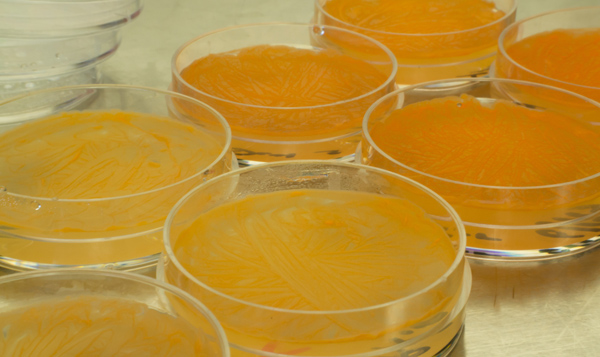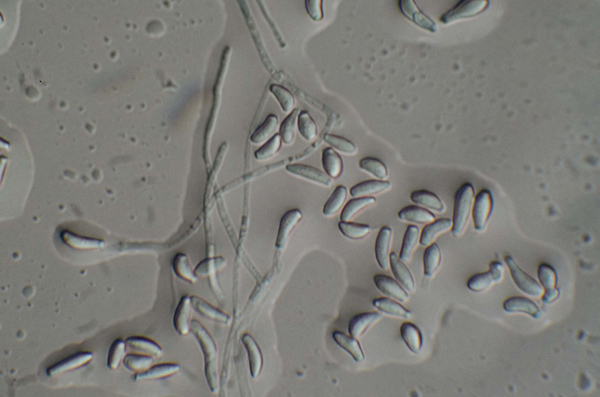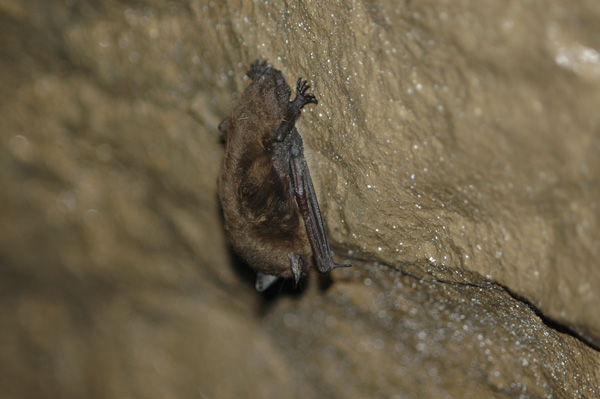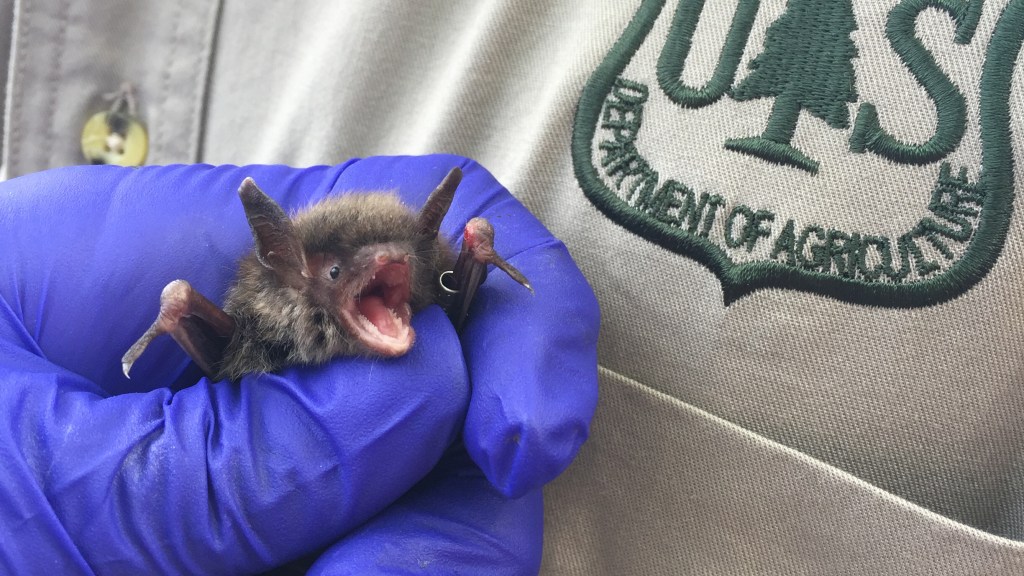Last week, 75 bats successfully treated for white-nose syndrome were released back into the wild in Missouri – rare good news in what has become one of the gloomiest wildlife stories in North America.
White-Nose Syndrome (WNS), caused by a fungus, has devastated bat populations in the eastern United States since it first appeared here almost ten years ago. An estimated 5.7 million bats have died, and conservationists have scrambled to find solutions.
The bats released last week all had White-Nose Syndrome, and were successfully treated with a common bacterium that releases Volatile Organic Compounds (VOC) with anti-fungal properties.
This hopeful story may be an important first step in managing WNS. And its scientific backstory is just as fascinating.
This innovative treatment’s development began not with bats, but with bananas.
That’s right: the bananas on your supermarket shelf play a surprising supporting role in bat conservation.

From Bananas to Bats
When researchers at Georgia State University began research on the common bacterium Rhodococcus rhodochrous they were not thinking about bats. They were not even thinking about fungi.
They were thinking about fruit. When bananas, peaches and other fruit are picked, the plants emit their own chemical signals. These begin the fruit’s ripening process.
When fruit has to be delivered thousands of miles to supermarkets – as is so often the case – it’s a race against time. The fruit can ripen and rot before it makes it to the store’s shelves.
Researchers were investigating the effectiveness of VOCs – emitted by the bacterium R. rhodochrous – in delaying ripening in fruit.

Researchers and graduate students began noticing another effect of these VOCs: fungus inhibition. The fruits exposed to the bacterium were not getting moldy.
Chris Cornelison was at the time a graduate student at Georgia State. He had been seeing the photos of dead bats piling up in caves, and a thought crossed his mind.
“I was standing there looking at a bucket of moldy bananas next to a bucket of bananas with no mold,” says Cornelison. “If the bacterium could be so effective on fungi on bananas, could it have similar effects on fungus on bats? It was one of those leaps of thought in science that maybe only a grad student could make.”
Cornelison, now a post-doctoral research associate at Georgia State, exposed petri dishes of the fungus that causes WNS (Pseudogymnoascus destructans) to the bacterium.
“The first exposure seemed too good to be true,” says Cornelison. “I had to test it five more times before I believed the results. It had dramatic effects on the fungus. It seemed like this could be a big step in managing white-nose syndrome.”
A Cooler Full of Bats
Other bat researchers and conservationists saw the potential for this bacterium and the potential to take action against a conservation issue that was frustratingly difficult to combat.
“When white-nose syndrome was first documented, we were scrambling to find information,” says Katie Gillies, director of the imperiled species program at Bat Conservation International (BCI). “We had to research the disease, understand how it works, how it spreads. But we also knew we had to take action.”
A number of partner organizations – including BCI, The Nature Conservancy and the U.S. Forest Service – worked with Georgia State researchers to test this bacterium as an initial tool to help manage WNS.
“In 2012, we tried our first crazy idea to build an artificial bat cave that could help us provide a hibernating place for bats that we could clean every year,” says Gina Hancock, state director for The Nature Conservancy in Tennessee. “Then when we formed a partnership with BCI, we kicked around what was the most promising work being done, and biocontrols came to the top of the list.”
Hancock notes that there was no public money being spent on this kind of research, so The Nature Conservancy and BCI sought proposals to accelerate the research.

At Georgia State, the laboratory results continued to be impressive. The next step was to test the bacterium on bats in a laboratory setting, and it worked. Bats suffering from WNS recovered.
Of course, the bacterium is essentially a biocontrol – a biological method of controlling an invasive species. As Cornelison notes, the use of biocontrol has a checkered history, one filled with unintended consequences.
The impacts of the bacterium on other native organisms would have to be fully vetted. But in the meantime, bats could be treated in a limited field setting.
First, bats suffering from various levels of WNS were collected in the wild. They are not actually treated with the bacterium; it’s the VOCs that have the anti-fungal properties.
The bats were placed in a mesh bags, then put in a large Yeti cooler containing plates of the bacterium. They stay there for 24 to 48 hours.
The treated bats were then placed in an enclosure in a wild cave, where they spent their hibernation. This spring, they were collected and tested for presence of WNS.
“We tested for their fungal load and compared that to the fungal load when we first captured them,” says plant pathologist Daniel Lindner, of the U.S. Forest Service’s Center for Forest Mycology Research. “The bats had no detectable signs of white-nose syndrome and could be released.”
Some of the bats had such severe wing damage from the fungus that they could not be released (these animals will serve as conservation ambassadors), but 75 were released at the Mark Twain Cave Complex in Hannibal, Missouri.
The bacterium does not cure WNS; it arrests the development of the fungus and inhibits its growth. But it is still a tremendous first step in finding ways to manage the disease.

From Lab to Cave
Could this bacterium be used to treat caves? Yes, but first more tests are needed. The treatment has to be tested for potential toxicity to other cave organisms, including native fungi. (This is why fungicides have not been used to fight WNS; they typically kill all fungi, not just the harmful species).
“We have to make sure it’s not going to upset the cave’s delicate ecology,” says Lindner.
Once those tests are completed, how do conservationists actually treat a wild cave? Researchers are considered a nebulizer that pumps the VOCs into the cave. “It’s a very sophisticated version of a commercial grade air freshener, like what a hotel might use,” says Lindner.
It could lead to treatment of caves, mines and bunkers – potentially creating safe havens for bats. “In this trial, we had to touch every single bat,” says Gillies. “The goal is to optimize this tool so that we can treat a large number of bats without touching them.”

Even then, this tool will not eliminate WNS.
“This is one tool but we will need many more to manage this disease,” says Lindner. “But tools like this could help us manage the disease. It buys time for bats to adapt to the disease and develop resistance. That could prevent extinctions and allow healthy bat populations to rebound.”
For several years, talking to bat conservationists was an exercise in despair, in helplessness. WNS is still a major problem, and one that will continue to require innovation and research on a number of fronts.
But the sight of bats – bats that would have died of the disease – flying through the woods after successful treatment suggests a new chapter in this story. A new hope. “We are finally at the point where we can intervene on white-nose syndrome,” says Gillies. “It is not a silver bullet. We need more tools. But it is a first step. A huge first step.”




Bats are so critical to our eco-system, but VOC bio-controls are seriously dangerous to our environment and not the toxic bandaid we want to use on bats or anything else, especially our bananas.
This article tricks us into thinking bananas cured bats of White-Nose Syndrome. But reading it details that this bio-control is a VOC chemical that will kill ALL fungi in our caves that are dependent upon a very delicate balance, and don’t actually cure the bats either.
The problem with bats is CLIMATE CHANGE. Our warming climate breeds the white fungi that grows on the bat’s noses and bodies. The problem with climate change is our dependence on fossil fuels and our destruction of our planet. Turning THAT around is what will help our bats.
Let’s hope that the weather people are right about a colder winter this year. That will do the most to help the bats and it won’t kill all our beneficial fungi starting another eco-imbalanced, catastrophic crisis. If we have a colder winter and the bats recover this year that bio-controls were used, where do you think the credit will go? Think the bio-control engineers will claim success?
If you think we have problems with our liberal, black, Democratic president, just THINK of what it will be like under Trump. I’m going out to help Hillary Clinton get in. It’s the best thing I can do for our environment.
Thank you for allowing us to respond,
Alex
Thank God for you people and your desire to save these precious creatures! Now how can I
help the ones I see flying overhead at my home each evening? Every time I see them I feel like celebrating.
If you get the funding, can you alter the VOCs to only attack that particular fungus? Like they are doing to viruses to attack others? That way you wouldn’t have to worry about the other fungi in the caves.
Drs. Amelon and Hooper from the University of Missouri deserve accolades for their unending part in this research endeavor. Sybil and Sarah were the instigators and bat lovers who worked with Chris to carry out the research mentioned in the article. Sybil doesn’t want another bat to die, and neither do I!
Could disappearing bees also have a fungal infection that is depleting populations…
Would this treatment help Tasmanian Devils? I saw a wildlife show about the white nose fungus on them. It was killing them ….
Could VOCs be used to treat herps infected by chytrid fungi?
A Facebook comment was made that this method for treating WNS has been neither publisher nor peer reviewed. It also suggested that reporting such until-reviewed science was irresponsible.
Is it true the science hasn’t been peer reviewed and published, and if yes, could you please talk about what you see as the ethical considerations about reporting on this type of research?
Would be interested to see this application for Snake Fungal Disease!
I am awed by the persistent collaborative work of scientists. Thank you all.
Thank goodness! When I first heard this news I was so happy and relieved! Bats are my favorite animal and I love them so much. Will keep hoping this is now the gateway for a great recovery for them!
Yay! Such GOOD news!
I live in Western NY on Chautauqua Lake. Every summer I enjoyed watching hundreds of bats fly around at dusk. I never had to worry about mosquitos. Last year and this summer I didn’t see one bat. Chautauqua Institution, a world famous summer cultural center, was famous for its bat population. Wherever you turned a visitor would see a bat house. Sadly they weren’t used in recent years. If researchers want to release experimental bats in our area, we would be very pleased.
When I was about 10-12 years old I spent a few years in an upstate boarding school. The school marm kept a bat in a large jar and I became fascinated with the wonderful creature. Though many people find bats to be repulsive I think that they are wonderful. They are one of nature’s magnificent creations and fill an extremely important niche in it’s hierarchy. Although most people are afraid of bats, the flying mammals are generally harmless to humans and actually perform a variety of useful services. Insects are a favorite midnight snack among the bat crowd. Blood-sucking mosquitoes and pests that can harm crops are toast before a hungry bat. Because of that, bats save farmers from having to spend millions of dollars on pesticides. Thank you so much for sharing this article.
Keep up the incredible work u r doing!!!!!!!!!